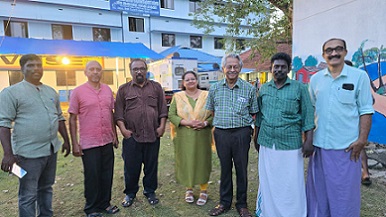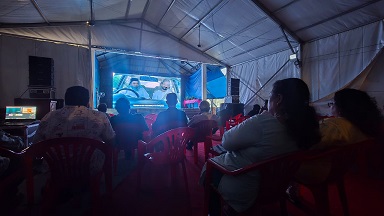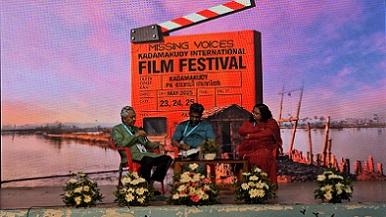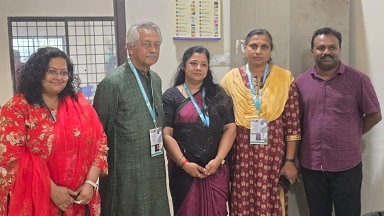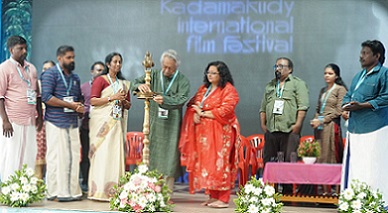K@IFF 2025
Kadamakudy International Film Festival (K@IFF), the first film festival that I have ever attended, was strange, beautiful, and totally unforgettable.
Held on a rain-soaked island in Kerala, K@IFF had no red carpets. Just honest cinema, roof leaks, and aunties serving steaming meals.
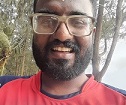
Sarat Alex
Advertising copywriter & aspiring scriptwriter
I went to a film festival. I’d never dared to before.
Coming from advertising, where we reverse-engineer for attention spans, I viewed arty films with a mix of suspicion and jealousy.
But I went. And now I want more.
It was the Kadamakudy International Film Festival.
Three rain-soaked days, May 23 to 25, 2025, on a tiny island in Kerala that felt made for cinema.
K@IFF, not KIFF.
The @ is no glitch. The location, the island village of Kadamakudy, is the main character.
My Rapido drove along a thin, straight road flanked by endless water, chinese fishing nets and blue, white, yellow fishing huts dotting the distance.
The rain played fast and loose – not ruining any plans, just setting the scene.
The venue was the Kadamakudy Government Higher Secondary School.
I reached at 1 PM. Just in time for lunch. That’s right. The festival served free food – delicious authentic Kerala fare cooked by local aunties. The food alone is reason enough to go.
In the school assembly hall, it was not exactly packed. Local uncles and aunties, kids in the front rows, volunteers next to equipment, and a few who looked like festival regulars. I sat behind the kids and waited.
“Piravi” began. The sound wasn’t great, French subtitles were distracting. But the masterpiece was masterpiecing.
The film is obsessed with rain. The rain on screen and rain outside started to blend oh-so-delightfully. A leak in the roof just in front of the screen made it a full 4D situation.
I found myself actually diving into the tragedy and finding it deeply delicious. I’d never felt this way before. I hugged myself in anticipation for more.
Then came “Alice in the Cities.” Road movie. German. Black and White. Bit of a triple whammy for an uninitiated audience. Walks were taken. Naps too.
Yet for me, it was a definite mood. A film that didn’t take you anywhere in particular, just across an America with meandering expansive loneliness and a Europe humming with questing restlessness. I enjoyed the ride.
I had to take the bus at 6, so my first day score was just 2.
Day two started with Padma Shri Girish Kasaravalli’s “Koormavatara.” He was one of the chief guests at the Kadamakudy International Film Festival.
The film was about Gandhi, or rather a man paid to act as Gandhi. I was astounded at how a film so illuminating could be so entertaining (I’ve since learnt that filmmakers balk at that word). I felt like I had missed Gandhi for a while. Like he’d gone on holiday. He came back to me in that damp assembly hall.
Director Girish later said, “Don’t confuse Gandhi the man with Gandhi the idea.”
I resonated with that. Today they keep dissecting the man to kill the idea. And boy, we need that idea so desperately in this age of fatherless behaviour.

“Piravi” began… The film is obsessed with rain… A leak in the roof just in front of the screen made it a full 4D situation.
“A Separation”, an Iranian film, was next. Twists and turns for humans being humans in a society being society.
People trying to do what they believe is right, yet suffering for it. Iranian cinema felt like an astounding universe of truth lying in wait for me.
Then came “Qadeesso,” a meditative malayalam film. A Cannes winner.
The young priest protagonist was sublime. The actor was at the festival and introduced the movie. While focused on the priest and Christian spirituality, the film quietly touched on class, caste, gender, mortality.
I remember marvelling at the well-appointed spaces the priests lived in. Maybe that’s the sugarcoating on the celibacy pill. I joke. Yet the comfort was real, as was the loneliness – “I’m not able to pray…” he says, not calmly, but in quiet desperation. You feel the weight of that silence.
The last film that day was “Dhabari Kuruvi.” Set in an Irula settlement deep in the forested, impossibly green Nilgiris.
A tribal teen trying to get an abortion. Unrelatable for urban male me? Not hardly.
Eye-opening, mind-expanding, heartbreaking. I felt the fragile freedom of the forest. I need more tribal stories. I need that thud of recognition again, when something far away suddenly feels like home.
Day three started with “Laapataa Ladies,” which I caught halfway through. A fun film. The audience of mainly women seemed to enjoy the hindi film, even with subtitles.
Ananya Kasaravalli’s “Harikatha Prasangam” began with two people and a camera looking for Hari, the protagonist. What followed was a chorus of voices, people who knew Hari, each offering a different version of them, tracing an evolution. The storytelling format, and the pacing it allowed, helped me stay detached at first. I could observe Hari as a character, not become him.
But slowly, inevitably, I fell in love. Hari was hypnotic in their beauty. And their innocence was quietly heartbreaking. Gender felt less and less of a way of being, more of a role we are forced to play under threat.
Sadly, I missed “Capernaum” and “Where Is The Friend’s House” which I later found out is on Herzog’s Rogue School watchlist.
But what I got instead was its own kind of cinema. A truly electric Kaikottikali performance by local girls, high energy, precise, and somehow defiant.
Followed by a panel discussion with Girish and Ananya Kasaravalli. He said something that stuck: a film is incomplete without a conversation about it.
I liked that. It elevated my understanding of cinema. From something you feel alone, to something you complete together.
Stories feel personal, always lived by one, but I guess by definition they’re always shared by many.
And the Kadamakudy International Film Festival had something rare to share. A certain sincerity. No red carpets. Just films, food, water, rain, stories.
Met some interesting people too. A priest who rebels like it’s scripture. A bureaucrat who made award-winning films. A women’s college English professor who sees through people like glass. A municipal driver and rising politician. A soft-spoken stranger from Kashmir.
Not to mention Girish and Ananya Kasaravalli, filmmakers with the kind of presence that makes you sit straighter, and then lean forward. I hung on to every pearl of wisdom they generously dropped.
A fun bit of drama unfolded off-screen too. There was talk of some drunk locals, maybe ideological rivals, trying to gherao the festival director because they misheard “backwaters” as “backward.” Probably a rumour, but adds to the legend.
K@IFF doesn’t feel like a one-time thing. It’s the start of something that might just grow on its own terms. There’s talk of monthly screenings and community discussions. Girish Kasaravalli, now announced as co-creative director, left behind a carefully curated watchlist. A quiet gift for future cinephiles.
The government should be paying attention. Or maybe they should leave well enough alone.
Kadamakudy International Film Festival has the bones and the spirit to become something rare. It’s in the place, the people and the stories. It could easily become an international phenomenon, if it doesn’t lose what makes it special.
Sarat Alex
Once ad-scorched in Mumbai, Sarat Alex drifted to Aluva and dissolved into the Periyar, where he swims daily and plots quietly. He makes pitch decks for startups he’ll never start, watches films he’ll never make, and reads books he won’t write. Unless he does.
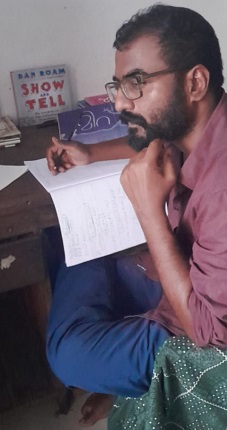
Share Widely

